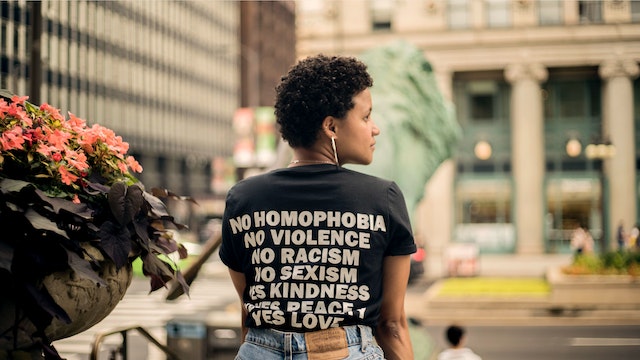Photo by Nicholas Swatz.
Today is International Women’s Day and this year’s theme is #EmbraceEquity. We didn’t just start fighting for equity today, nor during the summer of 2020 when society decided that caring about minorities, women, gender identity and people they consider as ‘others’ became the morally right thing to do. No, this fight has been an ongoing, complicated journey that dates back to the mid 1800’s. Often spoken in ambiguous terms that has left the interpretation open to any and everyone, it is naive for any of us to assume that when one speaks of equity, everyone is on the same page, thus proving why ‘equity’ has been hard to achieve for some.
So what does equity mean?
According to the Oxford Dictionary, equity is a noun. It means the quality of being fair and impartial. The word impartial is an adjective that means treating all rivals or disputants equally; fair and just.
Now that we understand what equity means, let’s take a quick trip down memory lane to gain a better understanding of the embracing of equity in the United States over the years and how supporting the act of treating others with fairness has benefited some women, while others are still fighting for acceptance.
In 1866 Elizabeth Cady Stanton along with Susan B. Anthony, Frederick Douglas, Sojourner Truth, Frances Ellen Watkins Harper and others formed the American Equal Rights Association (AERA). Shortly thereafter, they went their separate ways having fallen out over the 15th Amendment, which was passed in 1870 and gave Black men the right to vote. Douglas supported the 15th Amendment, but Stanton disagreed and went on to state her argument as to why formerly enslaved men should not have voting rights over white women. Unfortunately, Black women were not included in this equity argument, although women like Harriet Tubman and Frances Ellen Watkins Harper attempted to address how the AERA’s support of Black men and white women having the right to vote while excluding Black women was harmful.
Forty years after the passage of the 15th Amendment the Women’s Suffrage Movement started in 1910 and lasted for ten years. Again, during this time period Black women were actively involved. In 1920 Congress passed the Nineteenth Amendment, which prohibits states and the federal government from denying the right to vote to citizens of the United States on the basis of sex. History glosses over how the Nineteenth Amendment did not benefit the Black women who marched alongside white women and sang Kumbaya. Yes, our involvement was influential in the passage of the law, but unfortunately it did not protect our right to vote – especially in Southern states, which meant we could not participate in American politics and have a voice within the country that we lived and worked in, unlike our white counterparts.
Fast forward to the sixties when a second wave of the Women’s Right Movement emerged, along with the Civil Rights Movement gaining momentum. Under the leadership of then President John F. Kennedy, the Presidential Commission on the State of Women (PCSW) was convened in 1961 due to the encouragement of Esther Peterson, then director of the Women’s Bureau of the Department of Labor. Peterson believed it was the responsibility of the government to address the discrimination that occurred against women. A report was issued in 1963 from the commission, which according to the Center for Women in Politics and Public Policy at University of Massachusetts, Boston, addressed the “inequality women faced in many areas of American society and made recommendations on how to improve women’s lives.” Examples of some recommendations given included policies on expanding women’s access to educational opportunities, jobs with equal pay and childcare, and paid maternity leave. The Commission was chaired by Eleanor Roosevelt until her death and included women leaders, such as Peterson and Dorothy Height, who served as President of the National Council of Negro Women
Also it should be noted that in 1963, Betty Friedan published The Femmine Mystique which sparked the rebirth of feminism. Developed from a survey Friedan conducted during her 20 year college reunion at Smith College, Friedan’s book documented the emotional and intellectual oppression that middle class, educated white women were experiencing because of limited life options (they could not work outside of the home). In her book, Friedan described depressed, suburban housewives who had dropped out of college to get married and have children. She wrote that within her lifetime she had never seen a positive female role model who worked outside of the home and maintained a family. She spoke of how she and other housewives felt trapped. Although Friedan inspired thousands of white women to look for fulfillment beyond the role of simply being a homemaker, her work did not speak to the lived experiences of Black women, whom many worked outside of the home in domestic service positions. Labor data from that time period indicates that 51.2% of Black women made up the labor workforce in America while only 42.7% of white women were employed outside of the home.
Now when we throw the Civil Rights Act of 1964 into the mix, we begin to understand that it wasn’t just about equal rights for Blacks. The Civil Rights Act of 1964 actually opened the door for white women even more and has continued to protect them more than any other group over the last 58 years. Yes, the Civil Rights Act of 1964 ended segregation in public places and banned employment discrimination based on race, color, religion, sex, and national origin, but let’s not forget that the word sex was thrown into the bill in a last ditch effort to kill it, not to advocate for the rights of women.
Fast forward to today and the intersection of feminism, resilience, and equity in the context of Black and white women in America makes more sense. When we look at the historical timeline of events that were supposed to create equity for all women, what we see is a clear picture of how most (not all) white women benefited over Black women both legally and economically due to the difference in political agendas, societal beliefs in regard to the professional roles of Black women vs white women, and the difference in the lived experiences of everyone involved.
According to the American Association of University Women (AAUW), “Black women continue to face a wider than average pay gap despite the fact that they have participated in the workplace at much higher rates than most other women.” We also have to remember that affinity bias benefits white women in the workforce when it comes to hiring and promotion, as white men are more inclined to select a white woman candidate who reminds them of their mother, wife, sister or daughter vs the domestic help.
Yes, that good ole male patriarchy that white feminists hate so much has actually benefited them over the years. And although the concept of feminism has always focused on the need for women to become free from the bondage that was created by this patriarchy, affinity bias reminds us that white men will still look out for white women, while the education and work experiences of qualified Black women in America continue to be overlooked. Our contributions to this fight for equity has mainly benefited one group of women and it wasn’t us.
So now that you have the backstory and you’re feeling some type of way (enlightened, appalled, or mad as hell calling me everything but a child of God), you’re probably wondering how does one truly #EmbraceEquity on International Women’s Day for Black women?
- Celebrate Black women who are on the frontlines fighting for change. Acknowledge their efforts, share what you’ve learned from them with others, and give them credit when citing their work.
- Elevate the visibility of Black women creatives by holding space for them to exhibit their work. Also invest in their art and attend their events.
- Build workplaces where Black women can thrive both emotionally and financially. Offer unlimited personal time off, assist with childcare expenses and tuition reimbursement. Close the pay gap and pay us the same wages as our white male co-workers who are doing the same jobs. Provide employee assistance programs, employee resource groups, and healthcare that covers mental health so we can be vulnerable and share in safe spaces.
- Financially invest in community programs that support Black women equality. Yep, put your money where your mouth is and help these grassroots organizations not only survive, but begin to thrive and have a significant impact among those that they serve.
Knowing what you now know, let’s not spend the next 24 hours engaged in performative acts where we post ‘feel good’ pictures and sayings on social media, and attend events that offer no follow up action for change. Instead, let’s #EmbraceEquity by using our superpowers to make a significant impact in the life of a Black woman today.
If you found this article information click here and buy Dr. Yazeed a coffee.
Dr. Carey Yazeed is a behavioral scientist who specializes in psychological safety in the workplace. She is the author of Shut’em Down: Black Women, Racism, and Corporate America, Everyday Struggle: How Toxic Workplaces Impact Black Women (both were bestsellers on Amazon in the category of business conflict), and Unbreak My Soul: How Black Women Can Begin To Heal From Workplace Trauma. She is currently available for speaking engagements and to facilitate corporate trainings, Click here to learn more.







